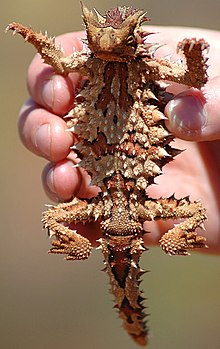| Revision as of 09:31, 20 November 2008 view sourceBackslash Forwardslash (talk | contribs)20,602 editsm Reverted edits by 5494v69s4v654v6 s46r4gf64evf6 to last version by Luna Santin (HG)← Previous edit | Revision as of 09:33, 20 November 2008 view source 5494v69s4v654v6 s46r4gf64evf6 (talk | contribs)5 edits →DietNext edit → | ||
| Line 40: | Line 40: | ||
| ] | ] | ||
| it loves grass lands and will eat ants and hunting spiders well thats what they | |||
| ==Diet== | |||
| say anyway the thorny devil has history that it was envoled from cave men | |||
| The food that the devil mainly eats is ants, often '']'' or ''Ochetellus'' (early reports<ref>{{cite web |url=http://uts.cc.utexas.edu/~varanus/moloch.html |title=Australia's Thorny Devil |accessdate=2007-10-31 }}</ref> indicate ''Iridomyrmex flavipes'' as the predominant prey, but this species was renamed ''Ochetellus flavipes'' in 1992<ref>{{cite web |url=http://www.ento.csiro.au/science/ants/dolichoderinae/ochetellus/ochetellus_tax_cat.htm |title=Australian Ants Online: Genus Ochetellus |accessdate=2007-10-31 }}]</ref>). They can eat some thousands of ants in one day.<ref name="Browne-Cooper"/> They collect moisture in the dry desert via night-time condensation of dew which forms on the skin and is channelled to the mouth in ] grooves between its spines (Bentley and Blumer 1962), and also during rain events. Capillary action allows the lizard to suck in water from its belly, all over the body, with capillaries ending near its mouth. | |||
| ==Ecology== | ==Ecology== | ||
Revision as of 09:33, 20 November 2008
| Thorny Devil | |
|---|---|

| |
| Conservation status | |
| Secure | |
| Scientific classification | |
| Kingdom: | Animalia |
| Phylum: | Chordata |
| Class: | Reptilia |
| Order: | Squamata |
| Suborder: | Iguania |
| Family: | Agamidae |
| Subfamily: | Agaminae |
| Genus: | Moloch |
| Species: | M. horridus |
| Binomial name | |
| Moloch horridus Gray, 1841 | |

| |
The Thorny Devil (Moloch horridus) is an Australian lizard. It is also known as the Thorny Dragon, Thorny Lizard, or the Moloch and is the sole species of genus Moloch.
It grows up to 20 cm (8 in) in length, coloured in camouflaging shades of desert browns and tans; these change from pale colours when warm to darker colours when cold. The species is entirely covered with conical spines that are mostly uncalcified. It also features a spiny "false-head" on the back of the neck, the animal presents this to a potential predator by dipping its real head. Females are larger than males. The Thorny Devil's body is ridged in structure, and helps the animal collect water which is channelled to the mouth.
Description
An intimidating array of spikes cover the entire upper side of the body, these thorny scales are a defence against predators. Camouflage and deception may also be used to evade predation. It has an unusual gait, involving freezing and rocking, as it slowly moves in search of its preferred diet.
Taxonomy and naming
The names of this dragon are given for its appearance, two large horned scales on the head complete the allusion to a devil. The species was described by John Edward Gray in 1841. While the species is the only one contained by the genus Moloch, taxonomists believe that another species may yet be described. The thorny devil is only distantly related to the morphologically similar North American horned lizards of the genus Phrynosoma, and is more an example of convergent evolution.
Habitat

It inhabits arid scrub and desert over most of central Australia. In particular, it inhabits spinifex-sandplain and sandridge desert within the interior and mallee belt. Its distribution largely coincides more with the distribution of sandy and sandy loam soils than with a particular climate (Pianka and Pianka 1970).

it loves grass lands and will eat ants and hunting spiders well thats what they say anyway the thorny devil has history that it was envoled from cave men
Ecology
A clutch of three to ten eggs is laid in September-December (spring-summer) in a nesting burrow about 30 cm underground, and hatches after an incubation of three to four months (Pianka 1997).
Predators include buzzards and goannas.
Popular reference
The popular appeal of the thorny devil is the basis of an anecdotal petty scam; American servicemen stationed in Southwest Australia were reputed to have been sold the thorny fruits of a weed species, called Double Gees (Emex australis), as 'thorny devil eggs'. The species has been kept in captivity, and is able to be handled.
References
- ^ Browne-Cooper, Robert (2007). Reptiles and Frogs in the Bush: Southwestern Australia. University of Western Australia Press. pp. pp. 46, 65, 158. ISBN 9778 1 920694 74 6.
{{cite book}}:|pages=has extra text (help); Check|isbn=value: length (help); Cite has empty unknown parameters:|chapterurl=and|month=(help); Unknown parameter|coauthors=ignored (|author=suggested) (help)
- Bentley, P. J. and F. C. Blumer. 1962. Uptake of water by the lizard, Moloch horridus. Nature 194: 699-700.
- Pianka, E. R. 1997. Australia's thorny devil. Reptiles 5(11): 14-23.
- Pianka, E. R. and H. D. Pianka. 1970. The ecology of Moloch horridus (Lacertilia: Agamidae) in Western Australia. Copeia 1970: 90-103.
- Science Podcast on belly-water-suction mechanism, August 24, 2007
External links
- Digimorph: Moloch horridus, Thorny Devil body structure
- High resolution close-up picture
- Australia's Thorny Devil by Eric R. Pianka


